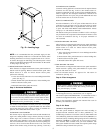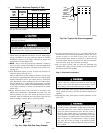
This gas furnace may be used for construction heat provided
that:
-The furnace is permanently installed with all electrical
wiring, piping, venting and ducting installed according to
these installation instructions. A return air duct is provided,
sealed to the furnace casing, and terminated outside the space
containing the furnace. This prevents a negative pressure
condition as created by the circulating air blower, causing a
flame rollout and/or drawing combustion products into the
structure.
-The furnace is controlled by a thermostat. It may not be ″hot
wired″ to provide heat continuously to the structure without
thermostatic control.
-Clean outside air is provided for combustion. This is to
minimize the corrosive effects of adhesives, sealers and other
construction materials. It also prevents the entrainment of
drywall dust into combustion air, which can cause fouling and
plugging of furnace components.
-The temperature of the return air to the furnace is no less
than 55 degrees F, with no evening setback or shutdown. The
use of the furnace while the structure is under construction is
deemed to be intermittent operation per our installation
instructions.
-The air temperature rise is within the rated rise range on the
furnace rating plate, and the firing rate has been set to the
nameplate value.
-The filters used to clean the circulating air during the
construction process must be either changed or thoroughly
cleaned prior to occupancy.
-The furnace, ductwork and filters are cleaned as necessary to
remove drywall dust and construction debris from all HVAC
system components after construction is completed.
DO NOT install the furnace on its back or facing down.
Safety control operation will be adversely affected. Never
connect return-air ducts to back of furnace. Failure to follow
this warning could result in fire, personal injury, or death.
(See Fig. 5.)
Step 2—Location Relative to Cooling Equipment
The cooling coil must be installed parallel with, or on the
downstream side of the unit to avoid condensation in the heat
exchangers. When installed parallel with the furnace, dampers or
other flow control must prevent chilled air from entering the
furnace. If the dampers are manually operated, they must be
equipped with means to prevent operation of either unit unless the
damper is in the full-heat or full-cool position.
AIR FOR COMBUSTION AND VENTILATION
Provisions for adequate combustion and ventilation air must be
provided in accordance with Section 5.3 of the NFGC, Air for
Combustion and Ventilation, or applicable provisions of the local
building codes.
Canadian installations must be installed in accordance with NSC-
NGPIC Part 7 and all authorities having jurisdiction.
When the furnace is installed in a residential garage, the
burners and ignition sources must be located at least 18 inches
above the floor. The furnace must be located or protected to
avoid damage by vehicles. When the furnace is installed in a
public garage, airplane hangar, or other building having a
hazardous atmosphere, the furnace must be installed in
accordance with the NFGC or NSCNGPIC. (See Fig. 6.)
Air for combustion must not be contaminated by halogen
compounds, which include fluoride, chloride, bromide, and
iodide. These elements are found in aerosol sprays, deter-
gents, bleaches, cleaning solvents, salts, air fresheners, and
other household products.
All fuel-burning equipment must be supplied with air for fuel
combustion. Sufficient air must be provided to avoid negative
pressure in the equipment room or space. A positive seal must be
made between the furnace cabinet and the return-air duct to
prevent pulling air from the burner area and from blocked vent
safeguard opening.
The operation of exhaust fans, kitchen ventilation fans,
clothes dryers, attic exhaust fans or fireplaces could create a
NEGATIVE PRESSURE CONDITION at the furnace.
Make-up air MUST be provided for the ventilation devices, in
addition to that required by the furnace. Refer to Carbon
Monoxide Hazard warning in venting section of these instruc-
tions to determine amount of make-up air required.
The requirements for combustion and ventilation air depend upon
whether the furnace is located in an unconfined or confined space.
Fig. 5—Prohibit Installation on Back
A02054
Fig. 6—Installation in a Garage
A93044
18-IN. MINIMUM
TO BURNERS
6
→
→


















